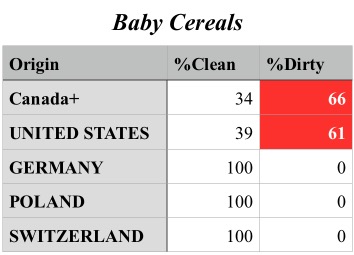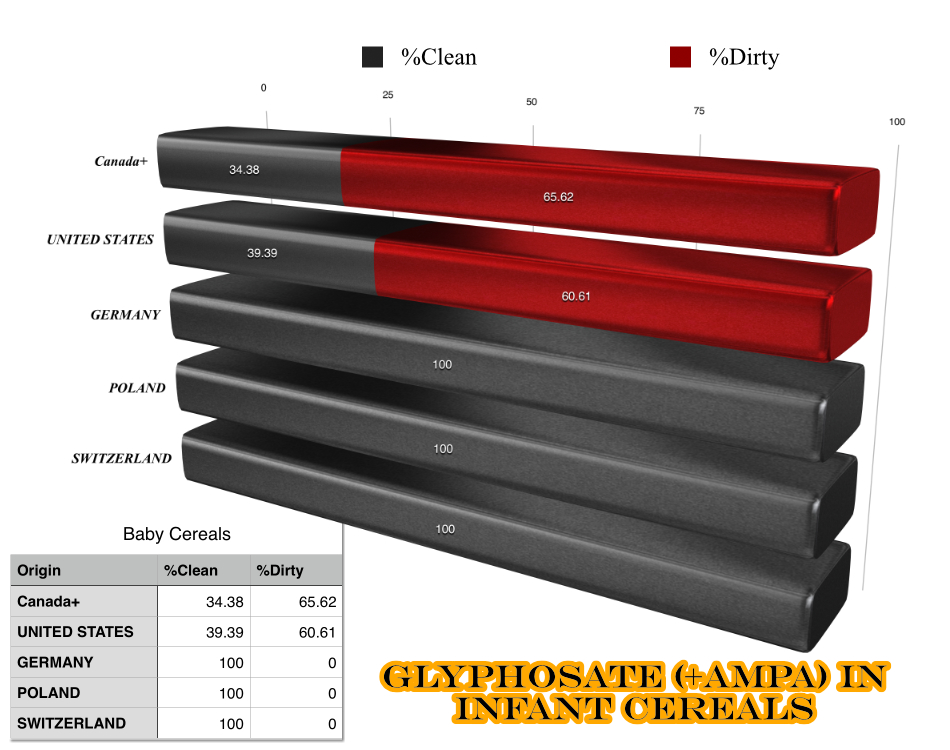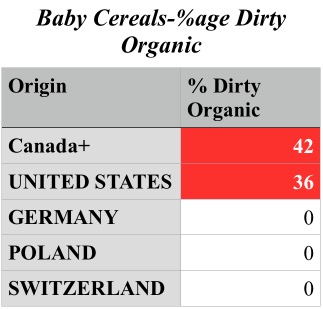I write this preliminary findings with a heavy heart and a serious concern regarding young children that might get damaged or hurt by glyphosate in their infant cereal.
I am in the process of going through several thousands of records of foods tested by CFIA for glyphosate, and am cleaning up, or typing more explanatory comments in additional fields so that later sorting can be done with less hassle and more clarity. And in the process I have come across a group of records of foods that CFIA describes as Cereal – Infant. A total of 119 tests were recorded on them, some for just glyphosate screening, with positive or negative results, while others were specifically to measure amount of glyphosate or AMPA is ppm, which I converted to ppb.
There were basically only a few countries of origin for the baby cereals, USA, Canada, Unknown, Germany, Poland and Switzerland. The “unknown” category has vexed me throughout this study, and since its numbers are usually higher than all others, and since Canadian sample numbers (without adding the unknowns) are less than the US samples, I strongly suspect that all, or nearly all, of the “unknowns” are of local (Canadian) stock. As it is, I think it is a law for foods from foreign countries to be displayed accordingly. So, I have started adding the Unknown with the Canadian readings and calling the combined lot as Canada+.
So, now there were just five countries of origin – Canada+, USA, Germany, Poland and Switzerland.

The readings from these samples showed a stark and ominous contrast. High percentage of Baby cereals from Canada and USA were dirty, in the sense that they contained glyphosate (and/or AMPA) while baby cereals from Germany, Poland and Switzerland were all 100% clean. Of course the number of samples from these three countries were lower, with 3 from Germany, 13 from Poland and 5 from Switzerland. Canada+ had 64 tests on baby cereal while USA had 33. And 66 percent of all infant cereals from Canada+ and 61% of all infant cereals from the US had glyphosate. Thats like two out of every three tests. And none of the European varieties had any measurable glyphosate. The above table has been converted to a percentage chart below, which depicts the high prevalence of dirty results from North American baby foods.
This has been a major cause of shock for me. I shall be later going into these with more details, to see if specific kinds of infant cereals are worse than other kinds etc. I already found out that going with the “Organic” variety might be better, but not a guarantee of clean food.

The table below highlights the issue. 42% of all organic infant cereals from Canada+ as tested had glyphosate. That is almost one of out two organic infant cereals that were dirty. The corresponding figure for the US is 36% or about one out of three. Among the European samples, one did not need to check for organic labels – they were all clean with regard to glyphosate.
Although my work with this food group is not over, I decided to make a preliminary report, which is correct as far as whatever I have written goes, to the best of my knowledge. However, I shall be digging deeper to see if there is any identifiable pattern that might separate the clean ones from the dirty, among North American samples. Clearly, going with organic labelling alone is not good enough.
 I found a few curious entries within the North American samples, which could be a give-away of its brand name. Three samples were described as Leapin’ Lemurs, Choco Chimp, and Koala Crisp. All of them were entered under infant cereals. I could not figure out what ingredients were used here, such as wheat, or oatmeal or rice etc, so I googled the names. It turned out, these are products by “Nature’s Path“. All three of them contained no glyphosate at all. So, out of this horror story, there was a sort of silver lining.
I found a few curious entries within the North American samples, which could be a give-away of its brand name. Three samples were described as Leapin’ Lemurs, Choco Chimp, and Koala Crisp. All of them were entered under infant cereals. I could not figure out what ingredients were used here, such as wheat, or oatmeal or rice etc, so I googled the names. It turned out, these are products by “Nature’s Path“. All three of them contained no glyphosate at all. So, out of this horror story, there was a sort of silver lining.
 I don’t have an infant at home and I do not like to eat processed food any more. However, I am very aware and conscious of the fact that infants and kids are far more vulnerable to illness and auto-immune triggers due to their low body weight and insufficiently developed immune system.
I don’t have an infant at home and I do not like to eat processed food any more. However, I am very aware and conscious of the fact that infants and kids are far more vulnerable to illness and auto-immune triggers due to their low body weight and insufficiently developed immune system.
So, for those that live in North America and must buy infant cereal, my preliminary advise would be one of the following:
- Buy European infant cereal, especially from Poland, Germany or Switzerland
- Or buy Nature’s Path products.
- Press your local public servants to start testing locally sold infant cereals for glyphosate content and let the public know the results, including brand name and source of the sample. Refer to petition on this.
I shall be digging into this more later, since I am only at around 2,700th of the record out of over 7,800 of them, and since I am a bit down with a flue-like symptom with a sore throat and a fever.
Trying to do the best I can to complete the work by around April.
Thanks for reading. Be warned – Infant cereals are that much more important because infants are that much more vulnerable. There are no safe levels of glyphosate, so I am not getting bogged down with exact ppb numbers and considering all tests including the straight glyphosate screening tests that does not give amounts in ppm or ppm but merely indicates if result is positive or negative.
Those that are interested on why there are no safe levels of glyphosate and how the Canadian and US government uses old fashioned and inadequate methods for checking safety levels for glyphosate, consider checking up on Anthony Samsel on two separate issues:
- Glyphosate mimics glycine and thus penetrates our cell biology
- Glyphosate damages out digestive enzymes.
In other words, EPA, Health Canada and the rest of the world needs to consider adding “enzymology” to the existing toxicology tests, before arriving at any conclusion on safety of glyphosate.
About Canada, Canada+ and Unknown
I am adding this section here as an answer to some questions raised by a reader, and also to address the issue from anybody else.
There are several reasons why I clubbed Canada with Unkown. These are:
- Taking samples from within Canada, one would assume the largest bulk of reading would be of Canadian origin. However, in actuality, the largest bulk often is “unknown” followed by USA and then Canada comes third. This does not make sense to me. Though in the case of this infant baby cereals, the numbers are reversed, with “unknowns” constituting a slightly lower sample number among the big three. I think I can guess the reason.
- Having a huge block of records without origin is absurd for any data collection and is perhaps a sign of sloppiness among the CFIA staff..
- There are laws about disclosing country of origin of food items, and since Canada actively protects its internal agricultural market from competition from abroad and doe snot allow free trade in agricultural goods produced in, say, USA, that Canada also produces, to freely cross the border, I suspect most of these unknown food samples are of local produce, and that CFIA staff might have done a sloppy job of describing bulk foods that do not come in a package and therefore origin is not printed anywhere, but was likely displayed at the store where it was collected. And that is perhaps one reason why, in this particular case of infant baby cereals, the unknown category represents slightly smaller number of samples than Canadian and US ones. Most baby cereals are packaged foods, and usually not sold in bulk without a container.
- This phenomena, of unknown samples usually outnumbering both USA and Canada, and Canada being the third largest source of supplies of foods collected inside Canada, applies to all other categories where the foods are not clearly processed and packaged, but are sold whole..
Lastly, if I keep Canada and ‘Unknown’ separate, then the glyphosate contamination for Canadian foods, including baby cereals turn out to be horribly and unbelievably contaminated. 87% of all Canadian infant cereals fall under that Category.
 Attached here is a table of the infant baby cereals for only three countries, to highlight my point – Unknown, Canada and USA, where Canada and unknown are kept separate. As you an see, the results bode much worse for Canada, with only 13% clean and 87% dirty. Another way of looking at it might be, if you are buying infant cereals, and if you can find “Canada” in the label somewhere – don’t buy it. Chances of you getting a slow dose of glyphosate would be seven our of eight !
Attached here is a table of the infant baby cereals for only three countries, to highlight my point – Unknown, Canada and USA, where Canada and unknown are kept separate. As you an see, the results bode much worse for Canada, with only 13% clean and 87% dirty. Another way of looking at it might be, if you are buying infant cereals, and if you can find “Canada” in the label somewhere – don’t buy it. Chances of you getting a slow dose of glyphosate would be seven our of eight !
